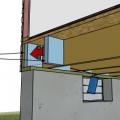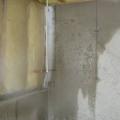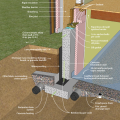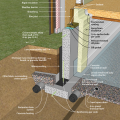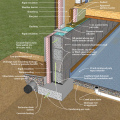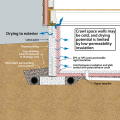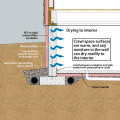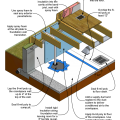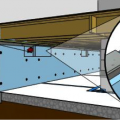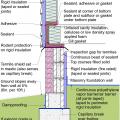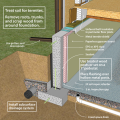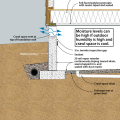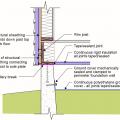Showing results 1 - 27 of 27
A concrete slab-on-grade foundation with exterior insulation, which can be elevated above the local grade as a flood-prevention strategy.
Because the above-grade potions of the wall lack exterior insulation, condensation and even ice form during cold winter conditions
Crawl space interior insulation with EPS or XPS semi-permeable insulation on inside wall
Exterior XPS basement insulation is correctly installed to completely cover the foundation wall
Foil-faced rigid foam and spray foam can be used to insulate a basement on the interior; use good moisture management techniques to keep the basement dry
ICF bricks are stacked to form hollow walls that are reinforced with steel rebar before the concrete is poured in
Pest proofing of this unvented crawlspace includes a metal termite shield that extends out from the sill plate, metal flashing wrapping the bottom of exterior rigid foam, and a termite inspection gap above interior rigid foam.
Right - Potential locations for crawlspace insulation: vapor sheeting should always cover the floor with insulation (a) outside walls, (b) inside walls, (c) both sides of walls, (d) sandwiched inside walls, or (e) under the first floor.
Right – Polyethylene sheeting vapor barrier is installed and sealed to the crawlspace walls with mastic
Right – Spray foam insulation was sprayed onto the ground and along the sides of the foundation walls and piers of this insulated crawl space.
Rigid foam insulation and a thin slab were installed over the dirt and gravel of this sealed crawlspace
This house with interior insulated crawlspace is protected from pests with termite shield at sill plate, borate-treated framing, flashing at end of wall insulation, and a termite inspection gap at the top of the rigid foam
Unvented crawl space with interior insulation - designed for termite resistance in heavily infested areas
Wrong – The polyethylene sheeting vapor barrier is not attached to the piers with mechanical fasteners

